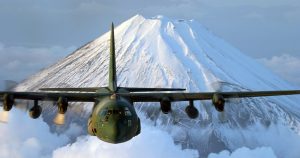Among UFO aficionados in Japan, summer is seen as the season for flying saucers. In mid-June Japan’s well known UFO hotspots didn’t disappoint after a mysterious unidentifiable white balloon with a connected cross-propeller shaped object was spotted in the skies of the northeastern city of Sendai and Fukushima prefecture. The mysterious aerial object was observed at 7 a.m. and some witnesses say it resembled a hot air balloon. Japan’s Meteorological Agency denied any observational equipment being dispatched by the agency. Miyagi Prefectural Police flew a helicopter to investigate the object but was forced to turn around due to poor weather conditions. Police say the aerial object disappeared without causing any danger to commercial flight paths. In December 2019 Fuji News Network (FNN) also reported capturing footage of an illuminating object in the sky traveling at tremendous speed in Iwaki City, Fukushima prefecture.
In late April then-Defense Minister Kono Taro announced plans to confirm a course of action in the event that Japan’s Self-Defense Force (SDF) encounters a UFO. Kono stated that while the SDF has not witnessed UFOs, the U.S Defense Department’s decision to release black and white footage of UFO sightings in April sparked concerns over Japan’s national security. The new official procedures, announced this week, expect the SDF to first make sure they are seeing an unidentified aerial object followed by taking written and photographic records for further analysis in addition to the collection of information provided by the public.
At a press conference on September 15, Kono said he hoped the new policy would be viewed as collecting information rather than searching for unidentified flying objects from space. Kono emphasized that UFOs are “indistinguishable objects, not objects from space.” Kono revealed that he personally does not believe in the existence of UFOs and made clear that drones could be one possible explanation. Kono referenced the case of a 2019 drone attack on a Saudi Arabia oil facility by an “unnamed flying vehicle” and stated that “it would be a lie if he had not kept drones in mind.”
In April the U.S Defense Department declassified military footage shot by U.S. Navy pilots showing three separate UFO encounters, one in 2004 and two in 2015. In early August the Pentagon launched an Unidentified Aerial Phenomenon Task Force led by the Navy to investigate whether UFOs pose a danger to aircrew safety and U.S. military aircraft. In a recent security meeting between the United States and Japan in Guam, Kono and U.S Secretary of Defense Mark Esper touched on the possibility of working together on UFOs as part of the Japan-U.S security alliance.
That marks a sea change from February 2018, when the Japanese government issued an official stance denying the existence of UFOs. The cabinet at the time issued a written response highlighting there was no special consideration on how to respond to unidentified aerial objects.
In 1992 a UFO research center and museum called “UFO Fureaikan” (UFO Friendship Center) was launched in Iinomachi, Fukushima prefecture partially funded by a 100 million yen government local revitalization grant. The center was built on a pyramid shaped hill called Senganmori that has developed a reputation for attracting UFO activity, supposedly because of the hill’s strong magnetic field.

































